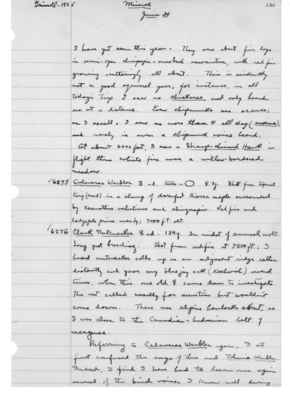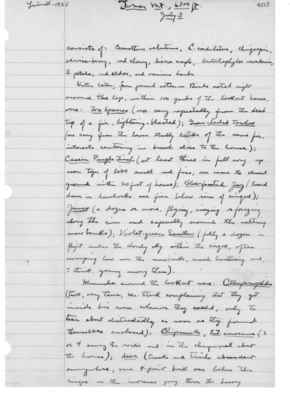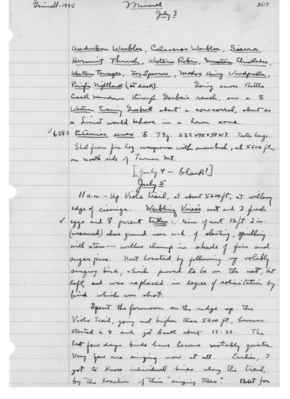Pages That Mention fir
1925: Joseph Grinnell's field notes
S2 Page 55
Collector: Grinnell - 1925 Location: Mineral Date: June 28 Page Number: 2508
poising, motionless, at times against the stiff west wind. Mrs. G. found a family of Golden crowned Kinglets in a group of young firs near camp - adults and 4 young, fully grown. I had a clear view of the two of the young - white line over eye, contrasted against dusky or blackish top of head.
June 29 8 a.m. - Traill Flycatcher's nest: in bog, chiefly grown to willow, but some white alder; located out in jungle, alongside of indistinct deer-trail; overtopped, well shaded, by lush green willow and older foliage; rim 1400 mm. above ground, nest insse^securely supported among cluster of upright small willow stems and emanating leaves. Taken (2/4)*, and [female symbol] parent shot.
Russet-backed Thrushes' nest: in same bog as last; rim 780 mm. above ground; situated in rather low willow clump, with larger (taller) clumps of willow and white alder about separated from one another by openings grown to lush grass and buttercup; a meadow stream runs 20 feet away. The green leafage above and all about the nest effectually conceals the nest until parted. The nest is supported on a slanting willow stem plus adjacent twigs and foliage. Taken (1/4)**, and [female symbol] parent taken; [male symbol] heard singing in vicinity mornings and evenings ever since we have been here. Mrs. G. found this nest. The site is almost directly between those of the two
S2 Page 58
Collector: Grinnell - 1925 Location: Mineral Date: June 30 Page Number: 2511
I have yet seen this year. They were about fir logs in semi-open chinquapin-snowbush association, with red fir growing scatteringly all about. This is evidently not a good squirrel year; for instance, in all today's trip I saw no chickaree, and only heard one at a distance. Even chipmunks are scarce; as I recall, I saw no more than 4 all day (amoenus), and rarely is even a chipmunk voice heard.
At about 6000 feet, I saw a Sharp-shinned Hawk in flight thru the white firs near a willow-bordered meadow.
6275 Calaveras Warbler [male symbol] ad. testes - [testes illustration] 8.3 g, Shot from topmost twig (dead) in a clump of dwarfed Sierra maple surrounded by ceanothus velutinus and chinquapin. Red firs and lodgepole pine nearby; 7000 ft. alt.
6276 Clark Nutcracker [female symbol] ad. 134 g. In midst of annual molt. Long past breeding. Shot from red fir at 7500 ft.: I heard nutcracker calls up on an adjacent ridge rather distantly and gave my bluejay call (Kochwish) several times, when this one old [female symbol] came down to investigate. The rest called nasally for sometime but wouldn't come down. There were alpine hemlocks about, so I was close to the Canadian-hudsonian belt of mergence.
Referring to the Calaveras Warbler again, I at first confused the songs of this and Tolmie Warbler. Indeed, I find I have had to learn over again several of the bird voices I knew well during
S2 Page 64
Collector: Grinnell - 1925 Location: Turner Mt., 6300 ft. Date: July 3 Page Number: 2517
consist of: Ceanothus velutinus, C. cordulatus, chinquapin, service-berry, red cherry, Sierra maple, Arctostaphylos nevadensis, A. patula, red alder, and various herbs.
Written later, from pencil notes. - Birds noted right around the top, within 100 yards of the lookout house, were: Fox Sparrow (one sang repeatedly from the dead tip of a fir, lightning-blasted); Green-tailed Towhee (one sang from the lower stubby limbs of the same fir, interests centering in the brush close to the house); Cassin Purple Finch (at least three in full song up near tops of live small red firs, one came to cleared ground within 20 feet of house); Blue-fronted Jay (heard down in the hemlocks and firs below rim of cirque); Junco (a dozen or more, flying, singing or foraging along the rim and especially around the melting snow banks); Violet-green Swallow (fully a dozen in flight under the cloudy sky within the cirque, often swooping low over the snowbanks, much twittering and, I think, young among them.
Mammals around the lookout were: Callospermophilus (two, very tame, Mr. Stark complaining that they got inside his room whenever they could, only to tear about distractedly as soon a they found themselves enclosed), Chipmunks, Eut. amoenus (3 or 4 among the rocks and in the chaparral about the house); deer (tracks and tails abundant everywhere, one 4-point buck seen below the cirque on the moraines going thru [sic] the heavy
S2 Page 66
Collector: Grinnell - 1925 Location: Mineral Date: July 3 Page Number: 2519
Audubon Warbler, Calaveras Warbler, Sierra Hermit Thrush, Western Robin, Mountain Chickadee, Western Tanager, Fox Sparrow, Modoc Hairy Woodpecker, Pacific Nighthawk (at dusk). Going across Battle Creek Meadows through Gerber's (?) ranch, saw a [male symbol] Western Evening Grosbeak about a cow-corral, about as a Linnet would behave in a lower zone.
6283 Eutamias senex [male symbol] 79g. 232x98x34x17. Testes large. Shot from fir log overgrown with snowbush, at 5500 ft., on north side of Turner Mt.
July 4 - blank!]
July 5 11 a.m. - Up Viola trail, at about 5600 ft., at willowy edge of cienaga. Warbling Vireo's nest and 3 fresh eggs and female parent taken: rim of nest 12 ft. 2 in. (measured) above ground near end of slanting, spindling will [sic] stem - willow clump in shade of firs and sugar pine. Nest located by following up volubly singing bird, which proved to be on the nest, but left, and was replaced in degree of solicitation by bird which was shot.
Spent the forenoon on the ridge up the Viola Trail, going not higher than 5600 ft., however. Started a [sic] 8 and got back about 12:30. The last few days birds have become notably quieter. Very few are singing now at all. Earlier, I got to know individual birds along the trail, by the location of their "singing trees." But for
S2 Page 67
Collector: Grinnell - 1925 Location: Mineral Date: July 5 Page Number: 2520
the most part, there [sic] are silent now. Tanagers, Hermit Thrushes and Warbling Vireos are still in song; but nearly all warblers, flycatchers and finches are quiet. Indeed, I heard the song of but one Hermit Warbler, where I heard dozens on June 22. Heard but 2 or 3 Audubon Warblers this morning. Heard a Grouse "boonting" in a big fir, so persistently that I circled the tree without disturbing him. I couldn't see him. Flushed a hen from the dusty trail, but failed to find any young.
6284 Hammond Flycatcher [female symbol] ad. 9.7g. Shot from fir twig about 30 ft. from ground in woods on ridge at 5500 ft. Note that molt has begun in innermost primaries, and that lower mandible is not especially dusky; indeed, it is quite pale flesh-color.
6285 Warbling Vireo [female symbol] 13.7 g. Contained fully formed yolk, a little "white" but not shell: would have laid 4th egg tomorrow. With nest and set 1/3 (incomplete, as above. ^Shot in willow. See p. 2519.
6286 Western Tanager [male symbol] ad. testes [testes illustration]. 28.6 g. Shot on ground beneath young firs, whither it had just; 5000 ft.
6287 Mariposa Fox Sparrow [female symbol] ad. 30.7g. Shot in thicket of arctostaphylos patula, in large tract of chaparral at about 5600 ft.
The young in the Wright Flycatcher's nest at camp, which hatched on June 17 (see p. 2491), left the nest voluntarily this forenoon sometime. Time in nest, 18 days ±.
6288 Bufo boreas found under board in our tent.




